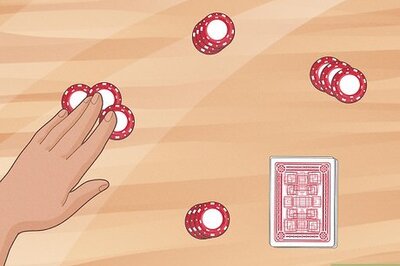
views
- Mix 1 tablespoon (15 mL) of vinegar, 3 drops of dish soap, and warm water. Pour the solution onto a cloth and use it to wipe down a wooden table.
- Use a mixture of warm water and dish soap to clean glass, plastic, stone, or stainless steel tables.
- Sanitize kitchen tables using sanitizing spray or a mixture of 1 tablespoon (15 mL) of liquid chlorine bleach for every 1 gallon (3.8 L) of water.
How to Clean and Sanitize Wood Tables
Wipe the surface with a damp microfiber cloth to remove dust. While dust may seem small, left unaddressed, it can act like sandpaper and damage the wooden surface. To get rid of dust, run a microfiber cloth under warm water. Wring the cloth out so it's not dripping wet and wipe the surface. You can also use a lint-free cloth or a feather duster. Be sure to dust weekly to keep your table clean and eliminate potential allergens. If you don't have any of these materials, use an old t-shirt or a washcloth to wipe the surface.
Use an old toothbrush to get rid of debris from any cracks on the table. Dirt can fall into hairline cracks within the wood, so find an old toothbrush or buy one for cleaning. Brush the bristles into the cracks in long sweeping strokes to try to eject the dust and dirt. For tough grime, go back with the toothbrush a second time. Wet the bristles and add a drop or two of mild liquid soap, then scrub until the cracks are clean.
Use or make a cleaning solution to wipe the surface. Mix 1 to 2 tablespoons (15 to 30 mL) of white vinegar, 3 drops of dish soap, and warm water. Pour the homemade solution into an empty spray bottle. You can also purchase a commercial wood cleaner. Spray or dampen a microfiber cloth with the cleaner, focusing on areas that look and feel grimy. If your wooden table has sticky or stubborn spots, mix equal parts olive oil, denatured alcohol, gum turpentine, and strained lemon juice to make a stronger solution. Do not allow moisture to linger on the wood for long. Dry wet areas immediately with a clean cloth. A porous table can become warped or deformed due to excessive liquid seeping into the wood.
Use mineral spirits to remove tough grime. If the homemade or commercial cleaners don't remove all the residue on the table, try dampening a cloth with mineral spirits and scrub at tough stains. Generally, mineral spirits are safe for use on wood, but try testing it on an inconspicuous area, like under the table, first to be sure.
Remove water stains with olive oil and vinegar. Water stains or rings on your wood table are actually pretty easy to remove. Mix equal parts vinegar and cooking oil (ideally olive oil) and use a soft cloth to rub the ring spot, working in the direction of the grain. Buff the area with another clean, soft cloth once the stain is gone.
Sanitize after cleaning to kill lingering bacteria. You can use a store-bought commercial sanitizer or make a homemade solution using 1 tablespoon (15 mL) of liquid chlorine bleach per 1 gallon (3.8 L) of water. Spray or pour your sanitizing solution onto the table, then wipe it down with a paper towel or clean microfiber cloth. Allow the surface to completely dry before sitting down for dinner. If you're using a commercial sanitizer, refer to the manufacturer's instructions, as some sanitizers may require you to wipe the surface with warm water and soap. This method works for sanitizing many surface materials.
How to Clean Glass, Plastic, Stone, or Steel Kitchen Tables
Remove dust, dirt, or crumbs with a dry microfiber cloth. Use a microfiber or lint-free cloth to get rid of any debris that's lingering on the table. You can scoop the dirt directly into the trash or onto the floor for vacuuming or sweeping afterward. If you have a glass table top that's completely transparent, wipe the underside for any dirt or dust as well.
Clean the table with a mixture of warm water and dish soap. For basic cleaning, dampen a cloth with warm water and wipe down the table's surface. If the table is heavily soiled, mix a bowl of warm water with a few drops of dish soap and use this soapy solution to dampen the cloth before you wipe the table.
Use white vinegar and water for glass or plastic tables. Mix equal parts of white vinegar and water in a spray bottle. Squirt the table with the solution and allow it to sit for a few minutes before wiping it down with a microfiber cloth. Opt for a cotton cloth with water and a mild, non-chemical liquid detergent for laminate tables. Stay away from products with acid or alkali and scouring pads or steel wool, as this can damage the material.
Use cleaners formulated specifically for granite, steel, and soapstone tables. Avoid abrasive or acidic cleaners if you have a stone table, like granite or marble. These can etch the stone. It's best to stick with dish soap and warm water or purchase a granite countertop cleaner. For stainless steel tables, use microfiber towels and stainless steel cleaners to get rid of any stains, smudges, and streaks. Scrubbing pads can scratch the surface. Clean soapstone tables with non-abrasive multipurpose cleaners. For tough scratches or stains, use very fine sandpaper (no rougher than 80 grit) and apply mineral oil afterward. EXPERT TIP Bridgett Price Bridgett Price House Cleaning Professional Bridgett Price is a Cleaning Guru and Co-Owner of Maideasy, a maid service company that services the Phoenix, Arizona metropolitan area. She holds a Master of Management from the University of Phoenix, specializing in digital and traditional marketing. Bridgett Price Bridgett Price House Cleaning Professional Look for non-hazardous, eco-friendly cleaners if you'd prefer a commercial product. Some of my favorite cleaning products are from the brands' Method, Mrs. Meyer's, and Bar Keeper's Friend.
How to Keep Your Kitchen Table Clean
Clean your table after each use. Remove any debris, crumbs, or spills after each use to keep your dining or kitchen table in tip-top shape to avoid stains or further damage. Use a homemade or store-bought cleaning solution and microfiber cloth to remove leftovers. Perform dustings weekly and thorough cleanings once per season.
Maintain a clutter-free kitchen table. To keep your table free of mess and potential mishap, create a separate area to catch mail, newspapers, loose change, and personal items. Use a bookshelf with baskets or small file boxes to sort any paper mail. Similarly, invest in small hooks or a coat rack to hang personal items—or at least hang them on the back of a chair and not the table! If it helps, keep a small trash can nearby to toss any garbage left on the table, such as junk mail.
Keep wooden tables in climate-controlled environments. Wood expands in fluctuating temperatures, causing the material to warp or split. Place your table away from heat sources like radiators or areas with direct sunlight if possible. If you can control the humidity levels inside your home, be sure humidity stays between 40 and 45% to avoid any cracks in the wood. You may require a dehumidifier or humidifier depending on the season.
Polish wood tables with wood wax to create a protectant layer. Purchase a wood wax at your local hardware or home improvement store. Use one cloth to wipe the tax on, applying with the grain in even strokes. Allow the wax to sit for 10 to 15 minutes. Then, use another cloth to polish and buff the table. You only need to wax your table about twice a year or as often as you'd like to restore shine.
Reseal stone tabletops with water or solvent-based sealants. Water-based sealants are more environmentally friendly, while solvent-based are more effective at penetrating the stone. In either case, both are effective at keeping your tabletops safe and polished. Pour or spray a small amount of sealant onto the cloth and rub it evenly over the surface. Allow it to absorb into the stone for about 15 minutes before wiping off excess sealant with a clean, dry cloth. Refer to the manufacturer's instructions on the sealant box. Leaving sealant for too long can discolor the stone. Granite will need to be resealed every 1 to 5 years.
Polish stainless steel tables with lemon oil and a microfiber cloth. While there's no need to seal a stainless steel tabletop, you can polish it with a store-bought stainless-steel polish or lemon oil. Apply the polish onto the surface of a dry microfiber cloth, applying in the direction of the grain. Buff with a clean microfiber cloth.




















Comments
0 comment